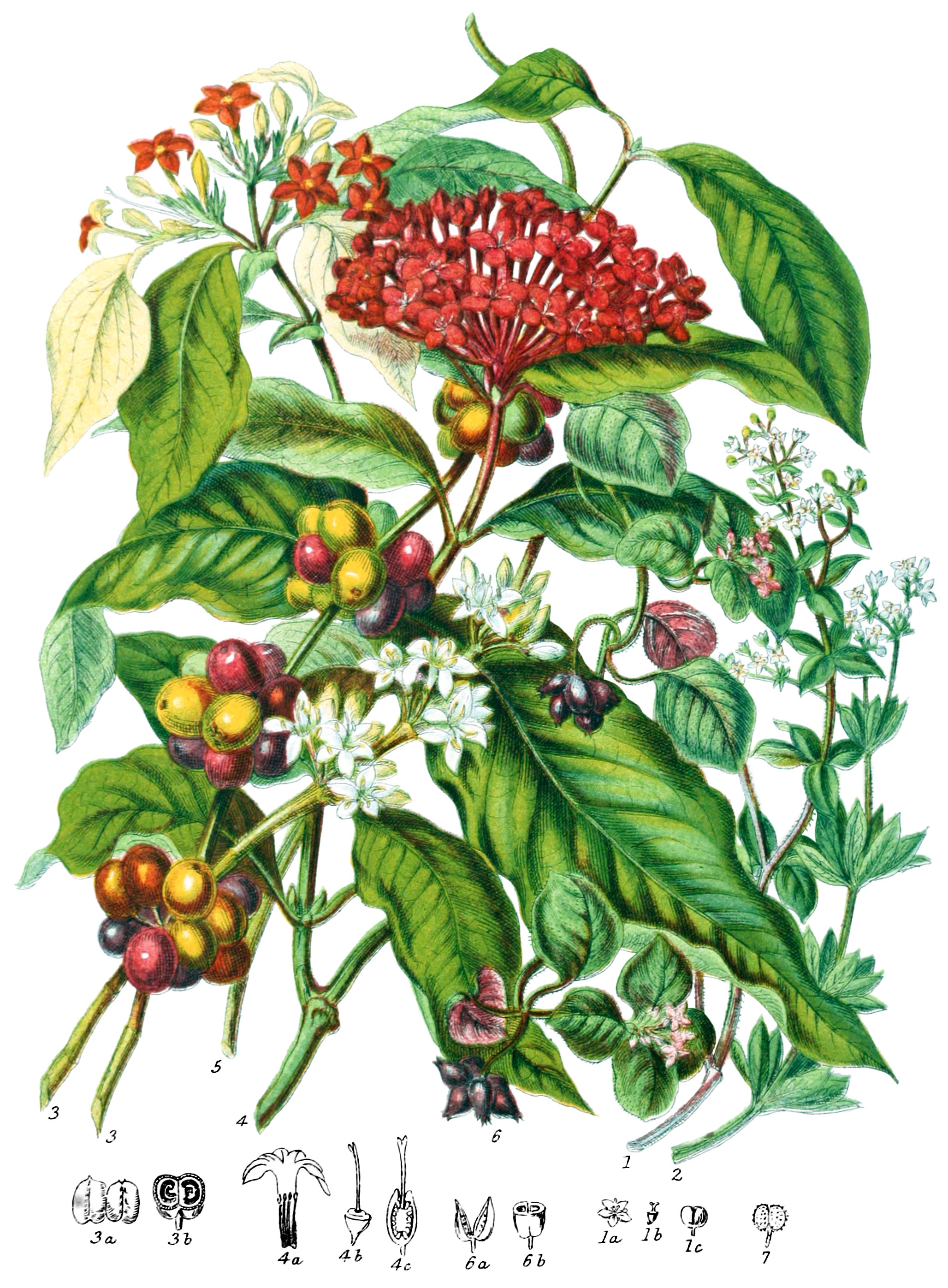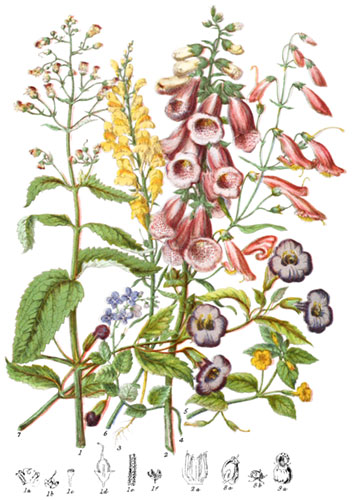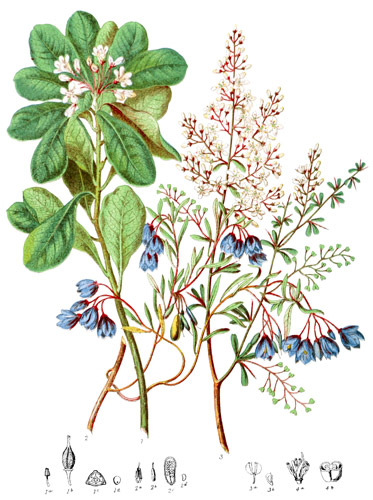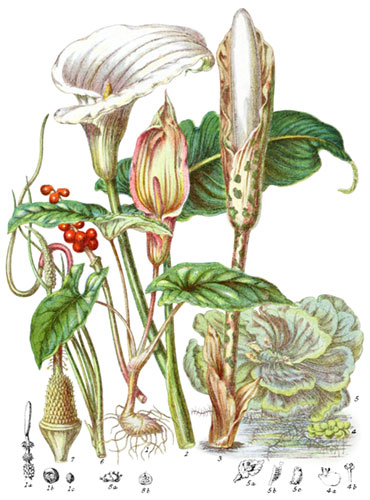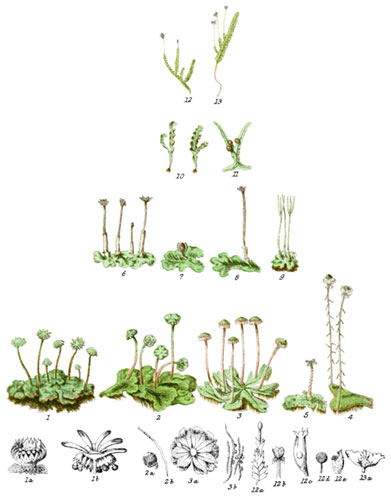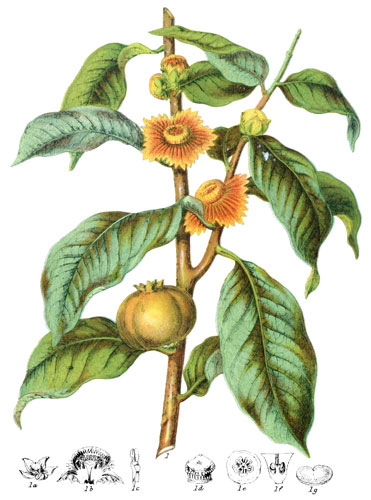Key characteristics
Trees, shrubs, and herbs: the leaves are simple, entire, opposite, and having stipules between the leaf-stalks, or in whorls around the stem and without stipules. The flowers are variously arranged, usually in clusters. The calyx is adherent, whole or divided at the top; the petals are flat, or tubular at the base, regular, with a definite number of divisions, equal to those of the calyx. The stamens rise from the corolla, and are alternate with its segments. The ovary is below the corolla, usually two-celled, sometimes many-celled; the style single or double; the stigma simple or divided. The fruit is whole or splitting into two parts, dry or succulent, two or many-celled. Seeds two or many, with horny albumen.
The characters of this order are clearly marked, but there exists considerable affinity with the Honeysuckle and the Composite tribes.
Poisonous, tonic, stimulating, and dyeing properties are contained in the varied plants of this extensive tribe.
Select plants in this order
Not all plants listed are illustrated and not all plants illustrated are listed.
- Rubia and its immediate allies form a herbaceous section of the Order, with angular stems and whorled leaves, possessing very little beauty of form or colour.
- R. peregrina (1) is the only British species, growing in sandy places in the west of England and Scotland; the creeping fleshy roots yield a red colouring matter, useful in dyeing.
- But the valuable Madder or Turkey Red is obtained from R. tinctoria, the chief culture of which is in Holland and Turkey, affording a large supply of red dye for wool and cotton.
- R. cordifolia is the madder of Bengla; another species is used in Chile.
- Asperula odorata (2) is a sweet-scented plant, frequent in moist shady places, particularly in Scotland; retaining its fragrance when dried, for a long time.
- The different species of Galium are common in various localities throughout England; none are of value.
- In the larger section of the order are some very important plants; the several kinds of Cinchona, in Peru, yielding medicinal bark; the small creeping-rooted Cephælis Ipecacuanha, in the damp forests of Brazil, esteemed for its emetic qualities; and numerous other species of medicinal value.
- But the most extensively useful of the whole tribe is Coffæa (3)*, first discovered in the mountains of Yemen, in Arabia, in the thirteenth century; two centuries later it was imported into Egypt, thence to Constantinople, and afterwards gradually into all the countries of Europe. Originally exceedingly limited in its place of growth, it has become widely diffused in cultivation, and still more widely dispersed by commerce. Arabia, however, still produces the best Coffee, in its dry climate, and on the arid soil of the mountain slopes. The hard, horny albumen of the seed, when roasted and ground, produces the stimulating and refreshing beverage.
- Mussœnda macrophylla (4) has the singular property of enlarging one of the sepals of the calyx, on each of the three branches of the flower-stalks, after the flower has fallen, one lobe acquires the size of a leaf, but is of a pale colour.
- Calycophyllum, also, has this peculiarity.
- Ixora (5) is one of the flowers employed by the Hindoos for the ornament of their temples; all the species belong to the East Indies and China.
- Vangueria edulis produces a fine eatable fruit in India and Madagascar.
- Genipa Americana is a large fruit of South America, of pale green exterior, containing a dark purple juice of agreeable flavour.
- G. Brasiliensis has a fruit which is also eatable when preserved with sugar.
- The fruit of Sarcocephalus esculentus, the Guinea peach, is eaten in Sierra Leone.
- Coprosma extends to the most southern land of the globe; in Tasmania it yields a fruit called native currants.
- Nerteria depressa grows about the Straits of Magalhaens.
- Fever bark is obtained from several species: from Rondeletia febrifuga, in Sierra Leone; from Pinckneya pubens, in Carolina; from Hymenodictyon excelsum, in East India.
- Cinchona has an extensive range on the Andes, occupying a space of ten degrees latitude on either side of the equator, and spreading over the mountains between 3000 and 9000 feet of elevation; the different varieties of bark are red, yellow, and pale. The attempt to transport some of these trees to Europe, first made by Condamine, failed, by the wreck of the boat at the mouth of the Amazons, after a prosperous voyage of 1200 leagues down the river.
- Several of the herbaceous plants of this tribe appear during the rainy season on the mountains of India, at 6000 and 7000 feet. Hymenopogon is a parasite on other trees; Oldenlandia is used for a red dye; Kohautia grows in the hot valleys between the hills—this is also a native of Africa.
- Some species of Morinda are cultivated in the plains of India for their red dye.
- Of the poisonous species, Evosmia corymbosa seems to be one of the most powerful, Indians having been poisoned by using the wood as spits for roasting meat in South America.
Locations
True Rubiaceæ are natives of the northern countries of the northern hemisphere, of elevated regions on the Andes, and of Australia. Cinchona, and its allies are natives of the Tropics, and other hot regions of the world. Pinckneya extends furthest north in North America, inhabiting the southern States.
Legend
- Rubia peregrina, Wild Madder. Britain.
- Flower.
- Pistil.
- Fruit.
- Asperula odorata, Sweet Woodruff. Britain.
- Coffæa* Arabica, Arabian Coffee-tree. Yemen.
- Seeds.
- Section of Fruit.
- Mussænda† macrophylla, Large-leaved Mussœnda. South America.
- Flower.
- Pistil.
- Section of Ovary.
- Ixora coccinea, Scarlet Ixora. East Indies.
- Coccocypselum Tontarea. Guiana.
- Fruit, open.
- Cross section.
- Fruit of Galium.
- *Coffæa was spelled “Coffea” in the original description and legend.
- †Mussænda was spelled “Mussœnda” in the original legend.
Explore more
Posters
Decorate your walls with colorful detailed posters based on Elizabeth Twining’s beautiful two-volume set from 1868.
Puzzles
Challenge yourself or someone else to assemble a puzzle of all 160 botanical illustrations.
